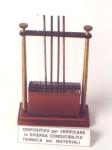

 Menu
Menu
|
Function Studying the expansion of solids. |

| ||
|
|||
|
Description The ring is anchored to a metallic curved pole. The sphere hangs from the end of the pole with the help of a small chain. There is an alcohol stove to heat the sphere. | |||
|
Function To study the conductivity of solids. |

| ||
|
|||
|
Description A prismatic metallic little basin leans on a rectangular metallic basis. From it rise two brass little columns joined, at the top, by a horizontal pierced bar. Four poles of different materials pass across the holes of the bar and they go down into the little basin. The top of the poles are covered with wax. By filling the little basin with warm water, the heat propagates along the poles. The quantity of wax melted will be proportional to the conductivity of the poles | |||
|
Function For experiments on the radiant heat. |

| ||
|
|||
|
Description The apparatus is complete for many experiments on radiant heat. It includes: an iron ruler divided into cms with very visible notches, supported by two brass columns fixed on a base of shining wood; a thermopile made fifty thermocouples, held at hinge by a mobile arm; a flat graduated circle for the experiments on reflection; a plate with a spirit lamp; one Locatelli’s lamp with a nickered reflector; a platinum spiral and a darkened cap; a darkened screen with a turning diaphragm with a hole of different diameter; a double turning screen at hinge. | |||
|
Function Conversion of radiant energy into mechanical energy. |

| ||
|
|||
|
Description The apparatus has a mica eddy and it is very easy to use. It is enough to expose it to whatever irradiation to obtain the rotation of the mobile part. It is a good example of the connective motion of the molecules that constitute the gaseous residue, due to thermal agitation. In fact, because of the irradiation, the fins of mica, which are darkened only on one side, get warm in a different manner on the two sides and therefore give different speeds to the molecules that constitute the gaseous residue. As a reaction the eddy moves around. | |||